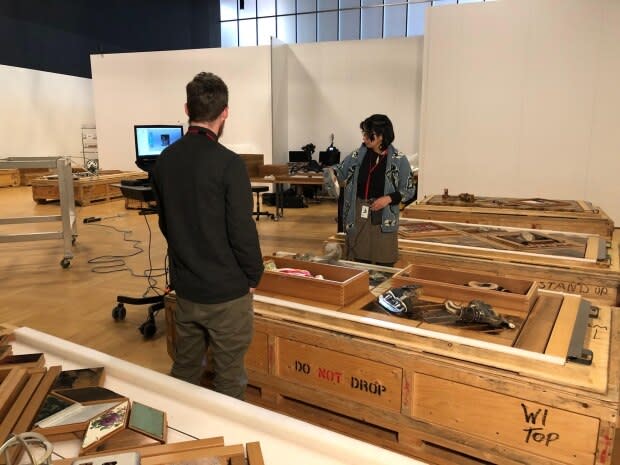Research team from B.C.'s Camosun College turns The Witness Blanket into virtual reality
Art commemorating the tragic legacy of residential schools may soon be available in isolated First Nations through a virtual reality project spanning Western Canada.
The Witness Blanket is a major art installation at the Canadian Museum for Human Rights in Winnipeg, Man., that recognizes the pain visited on Indigenous people during the residential school era. It has already toured Canada for several years, but mounting the large-scale exhibit in remote areas is a challenge.
That's why Camosun Innovates, a research hub in Camosun College on Vancouver Island, is creating a virtual reality version of The Witness Blanket that visitors who wear VR headsets can experience, making it accessible to Indigenous communities from coast to coast.
Camosun Innovates director Richard Gale was in Winnipeg last week with a VR expert and a visual arts student from the college, scanning all the 800-plus artifacts that make up the artwork. Some of the items were donated by Indian residential school survivors and their families, while others were reclaimed from residential school sites across Canada.
Visitors cannot touch the artifacts on The Witness Blanket that is covered with Plexiglas panels, but they can do so with the virtual national monument.
"Each of these [artifacts] tells a different story about the residential schools and the children who were part of that period," Gale told All Points West host Kathryn Marlow. "Rather than pulling out a drawer and looking at something in a museum, you can actually reach out and see what this thing really looks like in your hand."
More than 150,000 Indigenous children were forced into residential schools between 1870 and 1996 where they lived away from their families and weren't allowed to speak their own languages.

Detailed scan on each artefact on the Blanket
In the style of a woven blanket, The Witness Blanket is a 12-metre structure made of wood frames that hold together items ranging from letters and photos to fragments of buildings such as doors and bricks.
The VR project took physical as well as technical efforts from Gale's team which scanned the artifacts without their Plexiglas covers.
"We have the Blanket disassembled in one of the galleries... We're doing very detailed scans that will then be translated into point clouds and large scale data which we're going to map together and stitch it into a virtual experience."
Point clouds are sets of data generated by 3D scanners to illustrate the surfaces of objects.
VR facilitates engagement
Gale saw The Witness Blanket in person when it first toured around the country, but he said turning the artwork into VR is not about making it a better experience.
"It's [about] bringing that experience to more people and giving them an opportunity not just to see the Blanket, but actually to engage with it, to hear more about the stories, to be part of the environment where these artifacts were originally found."
The Witness Blanket was created by Kwakwaka'wakw artist Carey Newman, who is also a visual arts professor at University of Victoria. He will do part of the narration for the virtual Witness Blanket's soundscape that tells where the artifacts originated.
Listen to the interview with Richard Gale on CBC's All Points West:

